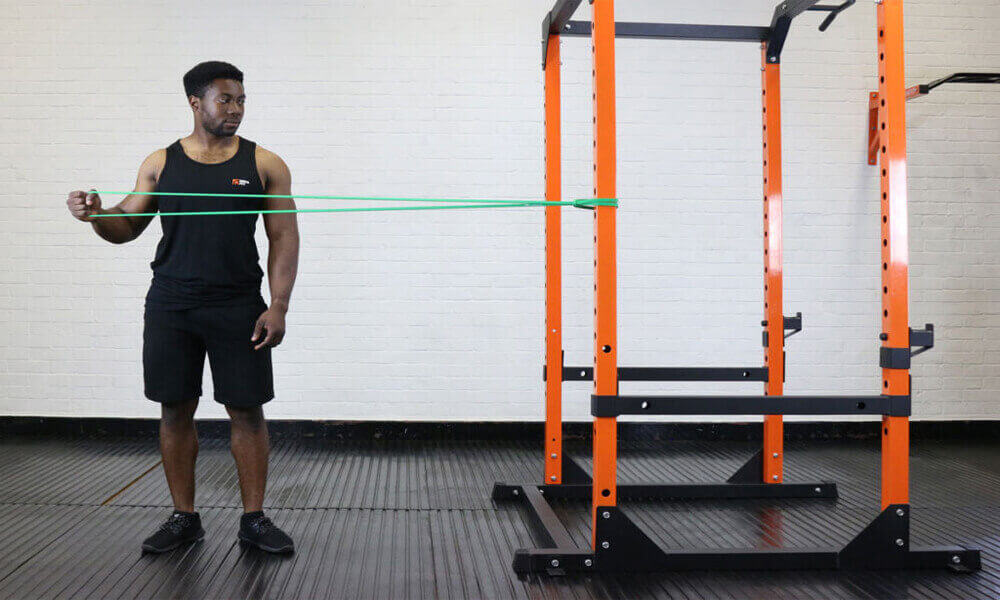Look around the gym and you’ll probably see a small pile of resistance bands somewhere – not being used.
Most of the time, people aren’t entirely sure how to use them. And often, they can simply get overlooked as it’s not always clear how they can help you progress.
However, if you’re used to the cable systems at the gym – whether it’s to do tricep pull downs or seated cable rows – you’re already employing the same strength concepts that resistance bands are built on.
And because they’re so versatile, it doesn’t matter whether you’re looking to build, strengthen or work on an old shoulder injury, they have almost an infinite amount of uses and benefits.
You just need to know how to use them. But once you’ve got to grips with the basics, the benefits are tenfold.
Below, we cover all the fundamentals of resistance band training, including what they’re typically used for as well as the different types of exercises you can do with them.
WHAT ARE RESISTANCE BANDS?
There are different types of resistance band. The most common (and best) types are the flat, resistance bands which are also known as strength bands or exercise bands.
They come in different widths. The thicker the width of the band, the more resistance it provides and equally, the harder it is to use.
Resistance bands start at level 1 and go right up to level 6. They are all the same length, however the level 1 resistance band is easier to stretch. This means it’s more suited to exercises that require a greater range of movement. And it’s also slightly easier to use so ideal for anyone who is just starting out.
Moving up the levels, they get harder and harder to stretch out. Until you reach level 6, which provides the most amount of resistance and is the most difficult to stretch.
It also provides the most counter balance. So, if you’re using resistance bands to support your weight while doing something like assisted pull ups, the level 6 band is a great one to opt for if you’re just starting out.
They are made from rubber and can be looped round gym equipment such as a rack or a stand, or simply used on their own.
They can be knotted to make them smaller – this can help when targeting your lower body. Or you can use your feet to stretch and anchor the band, to suit your height and ability.
WHAT DO RESISTANCE BANDS DO?
Resistance bands have a variety of uses:
- To build strength – each band exerts a particular amount of force on your muscles when stretched and can be used in both upper and lower body training.
- To improve mobility – resistance bands are a great way to help you improve your flexibility, but you can also use them improve joint mobility.
- For rehabilitation – bands have proved themselves essential for aiding recovery and are especially useful when it comes to working on hip, shoulder and knee injuries.
- For weightlifting – resistance bands are also used in weight training. Wrapped around the ends of a weight bar, they make exercises more challenging so you can level up your one-rep max. Equally, they can be used with dumbbells for a similar reason.
- For pull ups – resistance bands can also help you build up to doing pull ups. Loop them around the pull up bar and place your foot or knee inside the band to support your weight as you train.
-
RESISTANCE BAND BENEFITS
As you can see, resistance bands have all sorts of uses. And there are numerous benefits to including resistance band work in your training:
1) THEY IMPROVE THE QUALITY OF YOUR EXERCISES
2) THEY HELP TO FOCUS YOUR CONTROL
3) THEY RECRUIT YOUR STABILISING MUSCLES
4) THEY’RE FUNDAMENTAL FOR FUNCTIONAL TRAINING
5) A GREAT ALTERNATIVE TO MACHINES
6) THEY’RE LIGHTWEIGHT
7) THEY’RE DESIGNED FOR COMPOUND EXERCISES
8) YOU HAVE CONTROL OVER THE ANGLE
9) THEY PROMOTE BETTER FORM
10) THEY TEACH YOU TO FEEL WHAT’S WORKING AND WHAT ISN’T

